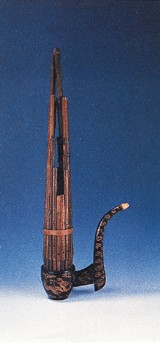1) craftsmanship of traditional sheng mouth organ making


传统制笙工艺
2) traditional milling technology


传统制粉工艺
1.
The gelatinizing characteristics of the flour produced by the technology of milling after debranning and the traditional milling technology were determined with RVA,and its relation to flour quality was studied by determining the damaged starch content in flour.
使用快速粘度分析仪(RVA)测定了采用脱皮制粉工艺和传统制粉工艺生产得到的小麦粉的糊化特性,并通过测定小麦粉的损伤淀粉含量等,考察了两种工艺条件下,小麦粉糊化特性和粉质特性间的关系。
3) conventional water treatment processes


传统制水工艺
1.
The removal efficiency of microcystins by conventional water treatment processes was investigated through laboratory study and detecting microcystins in every process in one water treatment plant.
通过模拟试验及水厂实测数据 ,考察了传统制水工艺对微囊藻毒素的去除规律 。
5) traditional technology


传统工艺
1.
The defects existing in the traditional technology of Muzi soy sauce making were analyzed,the improvement of traditional technology was achieved while retaining traditional product characteristics.
为保留传统产品特色,分析了母子酱油传统工艺中存在的缺陷,改进了母子酱油工艺。
2.
By breaking through traditional technology and adopting acidizing, the extraction ratio of molybdenum was raised and industrial production was realized.
通过对废催化剂中有价金属钼回收工艺的研究,突破传统工艺,采用酸浸法提高钼浸出率,实现工业化生产。
3.
This paper put emphasis on introducing the rose vinegar about its characteristics of the traditional technology, the production period, the brewing technology, and the fermentation regular pattern.
该文着重介绍了浙江玫瑰米醋传统工艺的特点,生产周期、酿制技艺以及米醋发酵变化规律,在此基础上对传统工艺进行分析,并提出了一些更新设想和措施。
6) traditional techniques


传统工艺
1.
This paper studied the traditional techniques and trait of Nanjing Brocade and discussed hat Nanjing Brocade’s applied in modern fashion design.
本文目的在与挖掘并提炼传统工艺-云锦的工艺价值,拓展云锦发展和应用的领域,使云锦这一历史文化悠久的民间传统手工艺,与现代社会以及文化时尚紧密结合,赋予其新的活力和应用价值。
2.
The traditional techniques of colored glaze ornaments have come into a mature stage in China after a long period of evolution, which show the light of Chinese aesthetic tradition.
经过漫长的发展演变,中国形成了一套成熟的加工制作琉璃艺术品的传统工艺,琉璃艺术体现着中国传统审美的精神。
补充资料:笙
| 笙 自由簧管气鸣乐器。中国传统气鸣乐器中能奏出和音的乐器,世界上最早使用自由簧的乐器。殷墟出土的甲骨文中已有象形文字记载。最初形制同排箫相似,用绳或木框把发音不同的竹管排列在一起。后来增加了竹质簧片和匏质(葫芦)笙斗。周代的乐器八音分类中,笙为匏类乐器,湖北随州曾侯乙墓出土的战国初期古匏笙,是中国发现最早的笙。春秋、战国至汉代,笙、竽是重要乐器,特别是竽。南北朝至隋唐时,笙有19簧、17簧、13簧多种,后又流行17簧义管笙,在17簧以外另有两支义管,供转调时替换用。唐代以后,又将体大质脆、吹奏费力的匏质笙斗改为木制。明、清以后,笙广泛应用于民间器乐合奏和戏曲说唱的伴奏中。
中国的笙于盛唐之时东传日本。在奈良东大寺的正仓院内,收藏着中国唐代制作的6支笙、竽。 现代笙为铜质笙斗。因流传区域广阔,外形有大小、圆方、长短的不同,常见的有苏笙、大笙、方笙、加键笙、转盘笙、抱笙和排笙等。苏笙最初流行于江南,现各地均有,在东北、华北叫小圆笙。除独奏外,也用于戏曲、歌舞的伴奏和器乐合奏。大笙又叫京笙或低音笙,体积比苏笙大。过去流行在华北、东北一带,现各地都有。方笙的笙斗为长方形,流行在河南、安徽等地。加键笙、转盘笙、抱笙和排笙等,都是20世纪60年代以后的改革品种。 各种笙的音域为:13簧a1~d3,14簧d1~e3,17簧高音笙a1~d3,17簧中音笙a~d2,中音抱笙d~#c3,低音抱笙 D~#c1,键盘排笙 D~e3。 |
说明:补充资料仅用于学习参考,请勿用于其它任何用途。
参考词条
